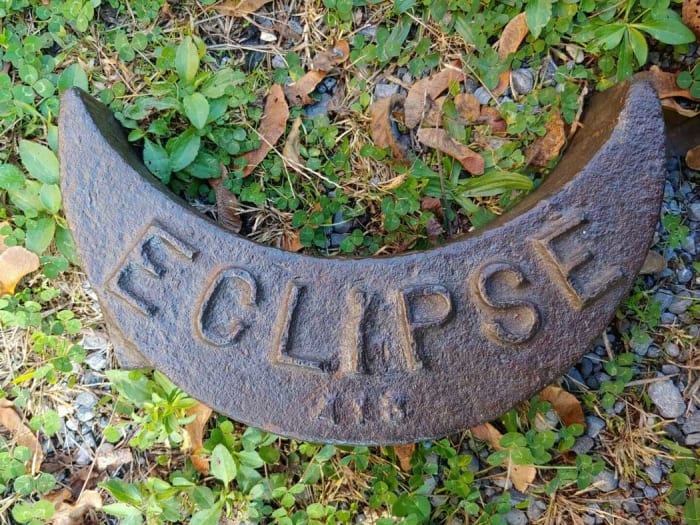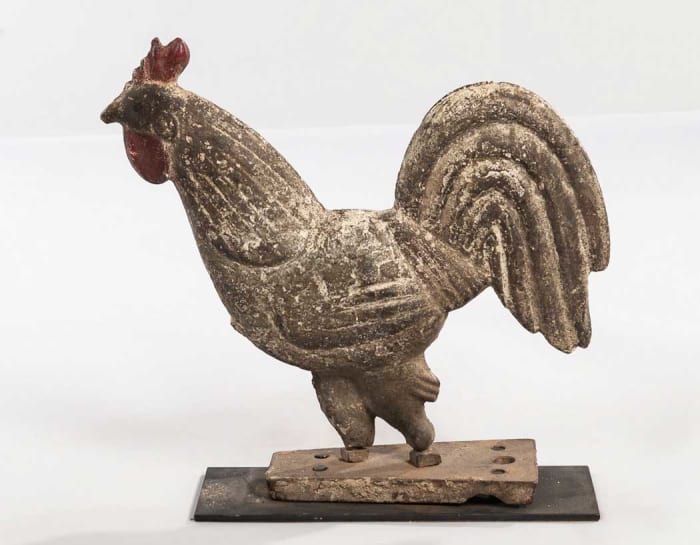
This so-called “Screw-leg” Rooster, c. 1870, is one of four known examples. Its legs are cast to make the rooster appear to be moving, giving it a more sculptural and animated feel than most weights. It sold for $8,750 at auction.
Image courtesy Bonhams Skinner
Windmills have graced the landscape throughout most of the world for centuries harnessing the power of the wind. But all through the United States and especially in rural areas, windmills were engaged in pumping water to service farm and ranch livestock, irrigating crops and to use for daily household routines, especially the American west. The heyday for the windmill in the U.S. was during the last half of the nineteenth century and well into the first half of the twentieth.
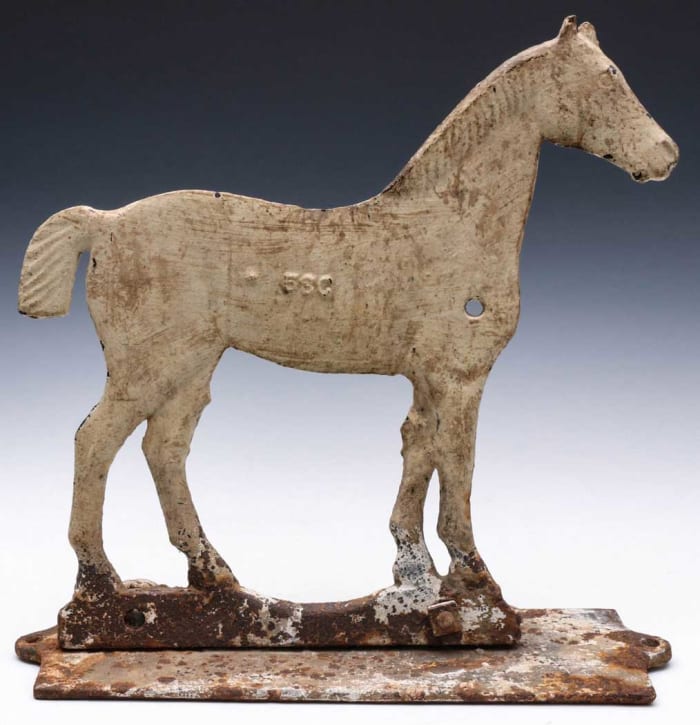
The Dempster Mill Manufacturing Co. bob-tail horse windmill weight in white paint, 17″ x 17 1/2″, sold for $950 at Soulis Auctions.
Image courtesy Soulis Auctions
With the enactment of the 1861 Homestead Act, settlers and would be farmers and ranchers turned westward to set up their homesteads. And when the Civil War came to an end those numbers grew. But once they settled upon their multi-acre parcels located on the treeless grasslands it became obvious the lack of water was a big problem.
One unnamed settler on the Great Plains summed up this dilemma with the following: “This would be fine country if we just had water.” And one settler heading back East was heard to say “Yes, so would hell.”
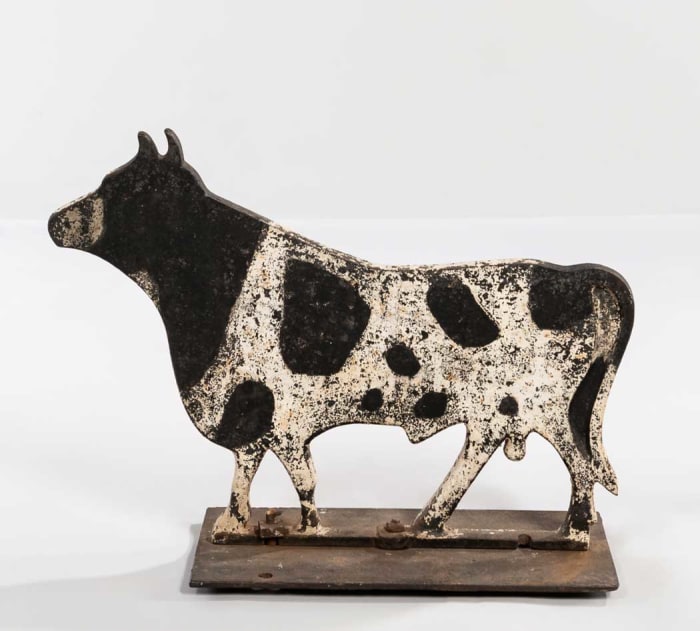
Black and white-painted cast iron bull windmill weight, Fairbury Windmill Company, Fairbury, Nebraska, c. 1900, 18 1/2″ x 24 1/2″, $1,375.
Image courtesy Bonhams Skinner
Windmills turned out to be a solution to the lack of water on the Plains. Sandwiched between 1880 and 1935, it has been written that more than 6.5 million windmills were manufactured by more than 200 companies. And windmill weights were needed for the huge number of windmills produced. Today these windmill weights are highly collectible for their striking appearance and can sell for as much as several thousand dollars.
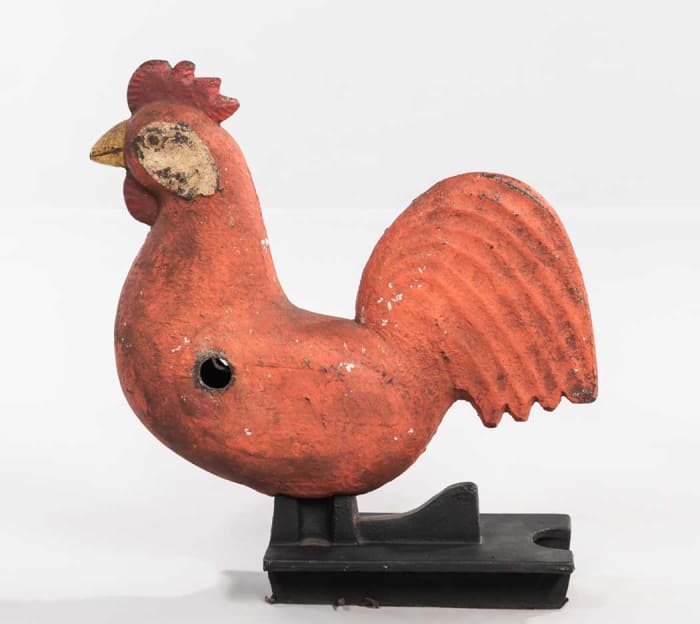
A cast iron ‘Mogul’ rooster windmill weight, Elgin Wind Power & Pump Co., Elgin, Illinois, c. 1880, 20-1/2” tall, sold for $6,250.
Image courtesy Bonhams Skinner
But what, exactly, is a windmill weight?
Windmills, made up of a series of blades attached to a narrow beam rotating at the top of a tower, required a heavy counterbalance at the other end of the beam to steady the blades and keep them pointed into the wind as it shifted. The weights varied in size and weight proportional to a windmill’s size. Bigger windmills needed heavier weights. The weights range from fairly light (some were hollow, designed to be filled with scrap metal) to as much as 100 pounds or more.
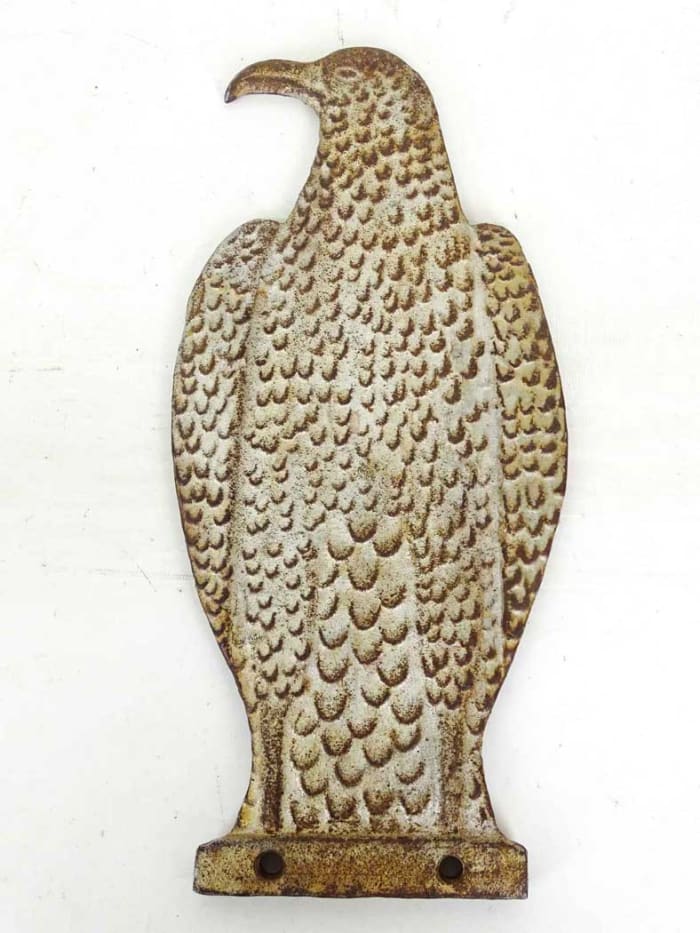
A cast iron double-sided eagle windmill weight, c. 1900, 15” tall, sold for $1,003 at Copake Auction.
Image courtesy Copake Auction
Often, the weights were made in foundries at or near the manufactories where the corresponding windmills were built. This meant that certain windmill manufacturers (Elgin Wind Power and Pump in Elgin, Illinois; Dempster Mill Manufacturing Company in Beatrice, Nebraska; and Fairbury Windmill Company in Fairbury, Nebraska; to name a few), became associated with what they produced. Certain shapes, sizes, and forms of weights were recognizable to the point where they began to function as advertisements for their makers.
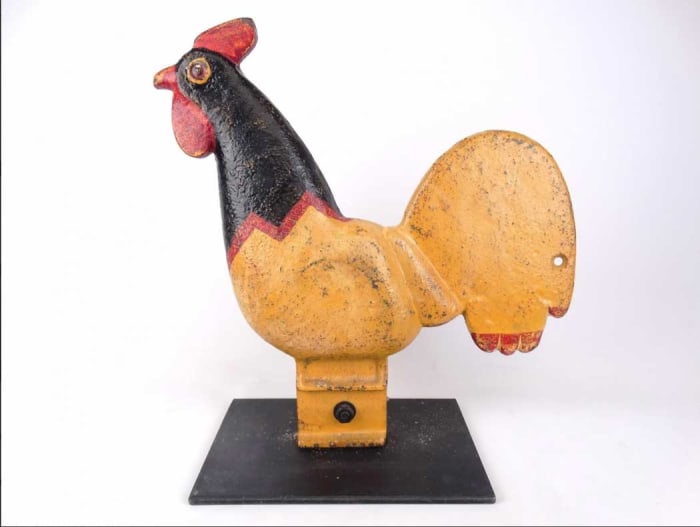
A ‘Barnacle Eye’ cast iron rooster windmill weight, c. 1900, from the Elgin Wind Power & Pump Co., Beatrice, Nebraska, mounted on stand, 18” x 18 1/2” tall, sold for $936.
Image courtesy Copake Auction
As a result, many weights are referred to using the manufacturers or model’s name – the Dempster Horse, the Fairbury Bull, the Mogul and Hummer Roosters. Others have taken on nicknames based on physical characteristics of the iron casting –the “Rainbow Tail” (referring to the graduated arches of the rooster’s tail), the “Barnacle Eye” (for the protruding nature of the bird’s eye) and the rare “Screw-Leg” Rooster, an example of which sold earlier this year for $8,750 at Bonhams Skinner.
Although a simple weight would have offset the weight of the wheel, distinct weights in the shape of buffaloes, crescents, eagles, hearts, horseshoes, orbs, squirrels and stars caught on.
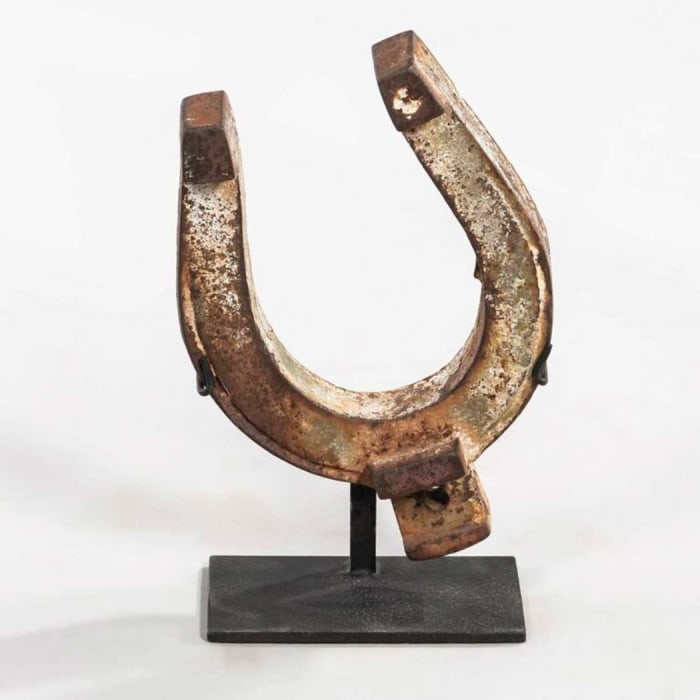
Silver-painted cast iron “Horseshoe” windmill weight, late 19th century, sold for $1,625.
Image courtesy Bonhams Skinner
Most original weights were solid cast iron. In an interesting aside, during the early 1890s with drought-like conditions, the Eclipse crescent moon with tips pointing downward were repositioned to point upward to “catch the rain.”
While a wonderful addition to any collection, caution needs to be taken because of the number of reproductions on the market. This is where provenance and reputable sellers are essential.
There are several excellent companies that deal in windmill weights: Bonhams Skinner, 1stDibs and Sotheby’s are just a few. If you do your homework, you can find reputable sellers on eBay. But again, be cautious because decorative reproductions are sold at much lower prices.
Sources:
Chris Barber, “Steady as She Blows:
Insight into Windmill Weights,” February 1, 2022. www.skinnerinc.com/news/blog/windmill-weight
Jason Combs, The Antique Detective, “Collecting windmill weights can fetch many dollars.” Kankakee Valley Publishing
Terry G. Jordan, “Windmills in Texas.” Agricultural History Vol. 37, No. 2
(April 1963), pp. 80-85.


